If you had asked me last week what was my favourite museum that I have ever visited – I would have answered the Musée de Moyen Âge (aka The Cluny Museum) in Paris. I’d been here twice before, and they have such a fabulous collection of medieval decorative artefacts all displayed in a gorgeous medieval building… it was always just a magical place to visit. In fact, The MET Cloisters in New York always felt a bit like it was trying to be this museum. The entrance to the Musée de Moyen Âge, as I remember it…

Let’s just say – it’s changed… A LOT. They’ve modernised. A medieval museum. For some unknown reason (likely something to do with getting people enthused and interested to come visit, and see really old things, and make it feel more interactive and more accessible to people* without any background or education in the Middle Ages) and well, to be completely honest, it feels like the entire place has lost its soul. (*notably: accessible to French speaking people – there was a map in various languages, and usually one large display board in French and English in each room, but most of the information plaques on individual objects were in French only). The entrance to the Musée de Moyen Âge as it is now:

Which is all very sad, but I tried to keep it to myself. Anyway, I was determined to see what I could and take as many pics as I could because fuck knows, you don’t see anything like this back home, ever. Downside of the no English plaques, is that I could only glean tidbits of information on the objects as I was looking at them; upside is that this prompted me to photograph a lot of the plaques so I could have a crack at translating them in Google later. So for some of these pics, there is going to be a bunch of info… and for others – none at all!
STUFF:
Pyxis (box) with scenes from the Life of Christ.
Byzantine Empire, early 6thC. Ivory bas-relief.
Resurrection of Lazarus, healing of the paralytic at Copernaum and of the man born blind, encounter with the Samaritan woman.


Christ in Majesty Known as the “Trébizonde Christ”.
Contantinople, early 6thC
Elephant Ivory bas-relief
Christ sits on a throne under a canopy, between St Peter, St Paul and two angels. On the lower register, angels walk towards a cross. This central plate of a large diptych (orginally from the collection of Martin le Roy), then of Marque de Vasselot), illustrates a moment in history when models from classical Antiquity were subtly adapted to Christian Byzantine iconography.
Liturgical Strainer with the name of St Albinus of Angers.
Frankish Kingdom. Late 6thC. Nielloed sliver and Rajasthani garnet (India).
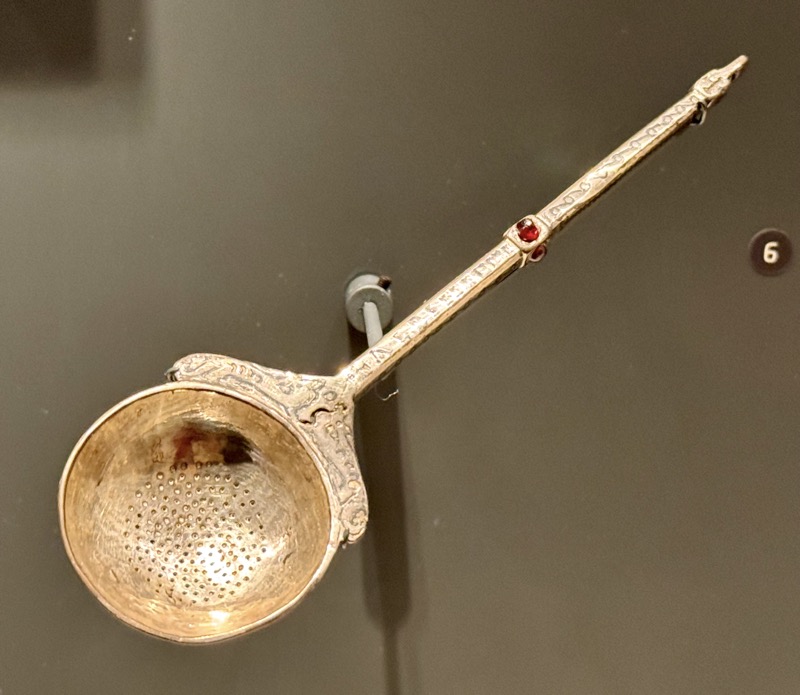
Fibulae brooches. Frankish Kingdom 6th-7thC.
Gilded silver, gold, garnet and glassware. From the Abbey of Clairvaux, (Aubre, France).
Pin was discovered in the tomb of Guillaume de Joinville, archbishop of Reims (1219-1226).

Arcy-Sainte-Restitue site. Two multifoiled cloisonné fibulae (brooches). Guilted silver, garnet, cast glass.

Fibulae inthe form of an eagle and belt-buckle plate.
Visigothic Kingdom, late 6th century. Gilded bronze, garnet and cast glass.
From Castel in Valence d’Argen (Tarn-et-Garrone, France). These two items probably comes from the same burial site. Both the stylised eagles come with compartmental decor and raised dots on the surface of the belt buck plate (with Indian garnet) are characteristic of Visigothic Art. The eagle motif is frequen in the early medieval kingdoms, which were receptive to the Imperial Roman symbolism of this bird of prey.


Diptych. England – 8th century (left) Italy (rigth). 10thC. Elephant ivory
From the treasury of the cathedral of Beauvais (Oise, France)
The re-use of these plates sculpted on both sides resulted in the levelling of the obverse side, where scenes of the life of Christ in an insular style (from the British Isles) can still be deciphered. The reverse sides feature exotic or imaginary animals amidst foliage framed by acanthus leaves. This second phase of sculptural work could be from a workshop in the Southern Alps.

Altar front of the Basel Cathedral. Fulda or Bamberg? (present-day Germany), 1st quarter of the 11th century Repoussé and stamped gold on oak core, precious stones, pearls, glassware From the treasury of the cathedral of Basel (Switzerland)
This antependium used to decorate the front of an altar. Five arcades stand out against a background of foliage with birds and four-legged creatures. Each one hosts a holy figure: Christ surrounded by the archangels Michael, Gabriel and Raphael, and Saint Benedict (founder of the Benedictine rule), who is glorified by the inscription. At the feet of Christ kneel Holy Roman Emperor Henri Il, who commissioned this antependium for the cathedral of Basel, and his wife, Kunigunde. Detail below:




Treasure of Guarrazar – Visigothic Kingdom, 7 century
Gold, sapphire, emerald, amethyst, rock crystal, jasper. pearls and mother-of-pearl
From La Fuente de Guarrazar, near Toledo (Spain)
These votive crowns are ex votos. Chains holding crosses and pendants used to hang from them. These pendant letters (the R is on display here) spell the name of two donors. One of them was Visigoth King Receswinth, who reigned in Toledo from 653 to 672. These crowns were probably royal offerings to the cathedral of Toledo. The archaeological discovery of the treasure (now split between the Musée de Cluny and the Museo Arqueológico Nacional de Madrid revealed one of the most important finds of the medieval Iberian period.


Christian motifs in Coptic art- Derived from Aiguptios in Greek and then qibt in Arabic, the word “Copt” defines the Christian civilization of Egypt, from the official birth of Christianity in Egypt (Edict of Thessalonica, 383). In artistic expression, a remarkable syncretism is revealed between pagan and Christian iconography. On the tapestries, Dionysus can be seen alongside a bowed character and the patterns of the patted cross and Chi-Rho (christogram) appear. The liturgical braid, depicting an archangel, the Visitation and Zechariah, is a rare piece of Coptic embroidery.
Egypt 5-6thC Wool and linen




Themes related to the Greek god, Dionysus were regularly depicted on ornamental tapestries for clothing, as shown here on two fragments of shawls. The kantharos is an accessory of the god of wine and ecstasy, closely linked to the art of theatre and poetry. The son of a slain mothe (Semele, struck down by a jealous Hera), saved by his father (Zeus, who carried him to term sewn into his thigh), Dionysus also embodies, in a certain way, the idea of bursting forth from beyond the grave.
Choosing Dionysiac themes for clothing linked to the afterlife was therefore probably not without symbolism in the Coptic world.
Tapestries with kantharoi, Egypt, 4th century, Linen and wool



Casket with mythological and battles scenes, casket plaque with a warrior.
Constantinople, late 10-early 1F century Bone bas-relief (on a core of wood for the casket)
About 1000, Byzantine bone carvers created caskets with secular themes inherited from classical Antiquity, especially legendary battles or circus games. This casket stands out by the quality of its sculpture and the fact that it is complete.
It used to belong to Frédéric Spitzer, a major 19 -century collector.



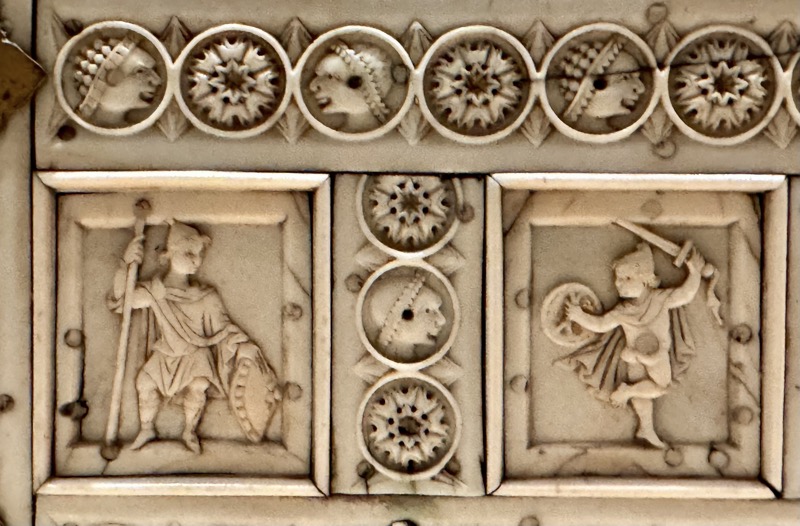


Two oliphants – fragmentary with animal frieze; decorated with an animal frieze, the Ascension and Saints. Southern Italy, 12thC, elephant ivory.
From the abbeys of Saint-Pierre-Saint-Paul of Bèze (Côte d’Or, France) and Saint-Arnoul of Metz (Moselle, France). Taking its shape from its material, an elephant tusk, the oliphant is first and foremost a horn. In the Middle Ages, oliphants were often associated with legendary facts, such as the death of the hero in the Song of Roland. The luxurious quality of this type of object made it enter church treasuries as relics. This is the case of this one in Metz (which used to be part of the collection of Frédéric Spitzer), known as the “horn of Charlemagne”.



Panels of the window of the Life of saint Benedict – Monks witness the ascension of saint Benedict
Ornamental border
Ile-de-France, 1140-1144, coloured glass, grisaille, lead. From the abbey church of Saint-Denis (Seine-Saint-Denis, France), ambulatory chapel.
Two monks witness the ascension to heaven of Benedict, their brother, who just passed away. The scene represents the final episode of a stained glass ensemble devoted to the life of saint Benedict, the founder of the Benedictine Order. It was placed inside of geometric panels (here, two half-medallions), at the top of a window. Each window consists of different scenes, juxtaposed and superimposed on one another, framed by an ornamental border of. varying lengths and widths. This sort of organization will endure for a century.

Two colonnettes and three sections of colonnettes
Colonnette: spiral strips decorated with acanthus leave bases and top to tail bunches of palmettes / Lower section of a colonnette: couples of birds and griffins facing each other, superimposed in follage: sprawling bunches of palmettes (possibly a complementary element of the next item) / Upper section of a colonnette: couple of griffins facing each other and bird spreading its wings with foliage motifs; sprawling bunches of palmettes (possibly a complementary element of the previous item) / Lower section of a colonnette: naked figures superimposed between pairs of birds and griffins facing each other; superimposed naked fighters / Colonnette: spiral strips decorated with inhabited follage and sprawling bunches of palmettes Tle-de-France, about 1135-1140. Lutetian limestone (liais)
From the western facade of the abbey church of Saint-Denis (Seine-Saint-Denis, France), jambs of the north and south portals. These six colonnettes decorated the jambs of the church’s western portals. They were stripped during the French Revolution. The three sections shown here are the sole remains of two or three of them, cut out in the middle of the 1820s to be reused as supports for low railings inside the basilica.

Jean Haincelin (Maître de Dunois) et Maître de Jean Rolin
Heures de Simon de Varye, Paris, vers 1455
Parchment.
Los Angeles, The J. Paul Getty Museum, MS 7, La Haye, Koninklijke Bibliotheek, ms. 74 G 37 and 37a
L’ouvrage est d’abord réalisé à Paris, autour de 1455 par le Maître de Dunois (Jean Haincelin) et le Maître de Jean Rolin, pour un commanditaire non identifié.
Il passe rapidement à un second propriétaire, Simon de Varye, commis à l’argenterie de Charles VII.
La devise « VIE À MON DÉSIR » est l’anagramme de son nom. Simon de Varye fait adjoindre trois feuillets indépendants dus à Jean Fouquet.
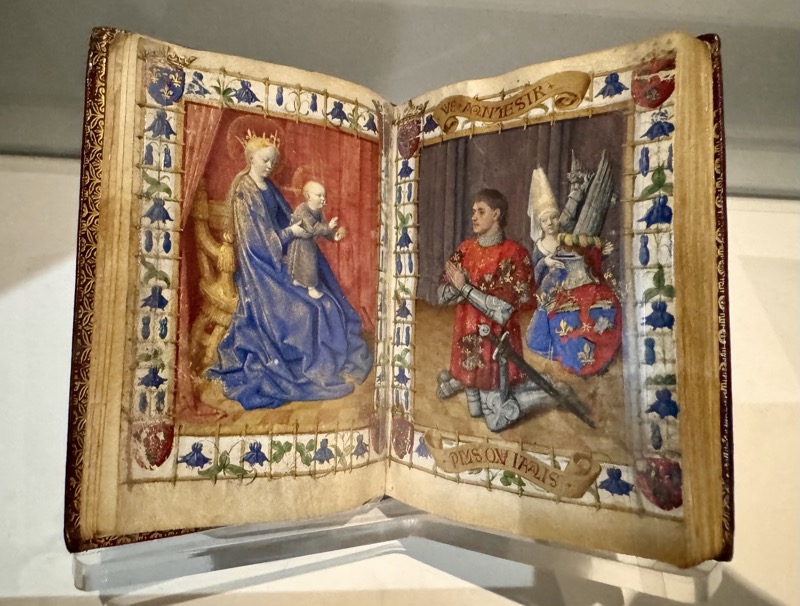


Sainte Anne et ses filles – Miniature issue des
Heures d’Étienne Chevalier, Paris, vers 1452-1455.
Parchment. Paris, Bibliothèque nationale de France, département des Manuscrits, NAL 1416
La miniature est issue du plus grand chef-d’œuvre enluminé par Jean Fouquet, les Heures d’Étienne Chevalier, aujourd hui démembrées, dont la plus grande partie est conservée au musée Conde de Chantilly. Le nom et le chiffre du commanditaire, trésorier de France outre-Seine et grand mécène de Fouquet, sont portés par les hommes sauvages. Mise en page comme un petit tableau, la scène montre sainte Anne et ses trois filles devant un panorama parisien.
La majorité des feuillets enluminés (40) du livre d’heures d’Étienne Chevalier est conservée au musée
Condé de Chantilly. En raison des dispositions testamentaires du duc d’Aumale qui les acquit en 1891, ils n’ont pu être prêtés à l’exposition. Celui-ci fit aménager spécialement le Santuario, dans son château de Chantilly, pour les présenter encadrés tels de véritables tableaux.


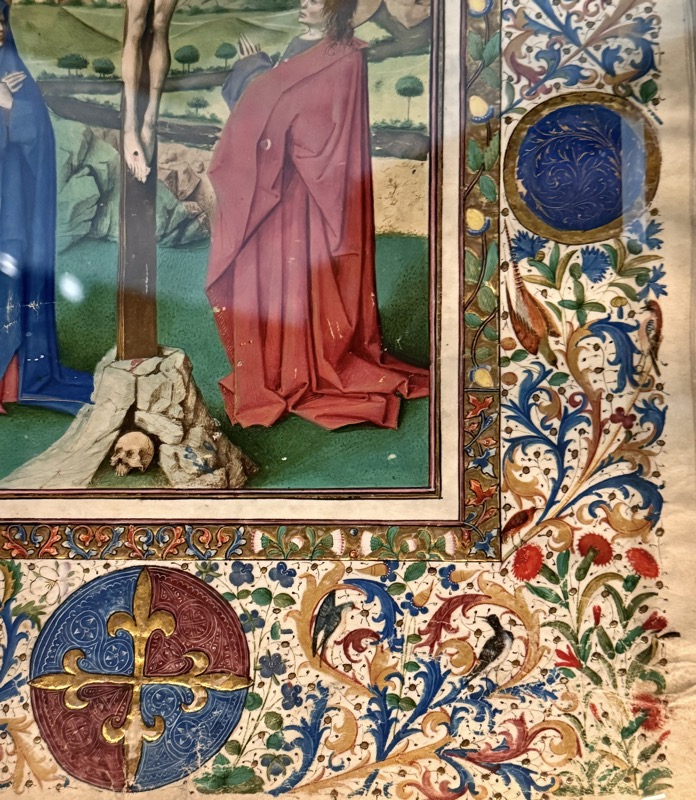

Jean Fouquet, Grandes Chroniques de France. Tours, vers 1415-1420 et 1455-1460
Parchment. Paris, Bibliothèque nationale de France, département des Manuscrits, Français 6465.
Le manuscrit renferme la première histoire officielle de la monarchie en langue vulgaire dont les origines remontent au règne de Saint Louis. Ses 51 petites miniatures ont été confiées à Jean Fouquet qui y utilise d’amples points de vue et un goût pour l’exactitude documentaire des lieux représentés. Il est peut-être le fruit de la commande du roi ou d’un de ses proches.



Pierre du Billant, on a cardboard by Barthélemy d’Eyck
The Healing of the Blind Woman (orfroi fragment)
France, 1444. Polychrome silks, gold and silver threads. Cl. 23424
This embroidery panel was part of a chapel (set of ornaments and liturgical vestments) dedicated to the story of Saint Martin. It illustrates a posthumous miracle of his life, that of a young blind girl from Lisieux who came by boat to the basilica and who, regaining her sight, thanks the saint. Pierre du Billant , embroiderer to King René, works there on the cartoons of his stepson, Barthélemy d’Eyck: the squat canons with massive heads and thick lips, and the oblique glances are characteristic of the latter’s art.





Barthélemy d’Eyck
René d’Anjou, Traité de la forme et devis comme on fait un tournoi, dit Le Livre des tournois
Angers (?), vers 1462-1465 / Papier Paris, Bibliothèque nationale de France, département des Manuscrits, Français 2695





André d’Ypres (Maître de Dreux Budé) – Triptyque de Dreux Budé
Paris, vers 1450 0 Volet gauche : Le Baiser de Judas et l’Arrestation du Christ avec Dreux I Budé et son fils Jean Ill présentés par saint Christophe
Huile sur bois. Paris, musée du Louvre, département des Peintures, RF 2015-3

Exceptionnellement réunis, ces panneaux forment l’un des triptyques les plus ambitieux de l’art parisien du xve siècle à nous être parvenus. Il a été commandé par Dreux Budé, notaire et secrétaire du roi mais aussi prévôt des marchands, représenté sur le volet de gauche. Le retable est destiné à la chapelle qu il a fondée dans le chevet de l’église Saint-Gervais-Saint-Protais à Paris. Le peintre qui tire son nom de ces tableaux a été identifié à André d’Ypres. Usant des plis marqués et des corps graciles, ce dernier y montre une certaine allégeance à la leçon de Rogier van der Weyden. Il a peint ici le plus ancien tableau français conservé figurant une scène nocturne.

D’après un carton de Jacques Daret – Délivrance de saint Pierre
Pays-Bas méridionaux, avant 1461. Laine et soie
Paris, musée de Cluny – musée national du Moyen Âge, CI. 1235
La tapisserie comporte aux quatre angles les armes de Guillaume de Hellande, évêque de Beauvais de 1444 à 1462, et du chapitre de la cathédrale Saint-Pierre de la même ville. Elle est le fruit de la commande de ce chapitre cathédral auprès de l’un des grands centres de tapisserie des Pays-Bas bourguignons. C’est le peintre d’origine tournaisienne Jacques Daret, formé dans l’atelier de Robert Campin, qui en a donné les cartons. C’est grâce à l’importation d’œuvres comme celle-ci que les nouveautés se diffusent dans le royaume de Charles VII.

This is what I meant when I said the museum had changed a lot… the artefacts and tapestries used to hang on the stone walls of the building, now the entire interior of the museum has white walls installed for the art to be viewed on, and it doesn’t feel Iike it is ‘in situ’ anymore.

Anges, Val de Loire, vers 1460-1470.
Pierre calcaire, traces de polychromie
Tours, musée des Beaux-Arts, inv. HG D 964.002.00001 et HG 968.028.0001
Portant les armes de Jean V de Bueil et de Jeanne de Montjean, ces deux anges (d’une série de quatre) proviennent du tombeau érigé par la famille de Bueil dans la collégiale Saint-Michel de Bueil-en-Touraine (Indre-et-Loire). Amiral de France en 1450, Jean de Bueil a joué un rôle important dans la reconquête du royaume par Charles VII. Stylistiquement proches du gisant d Agnès Sorel, ces anges montrent cependant une recherche d’animation plus marquée, avec des drapés épais et creusés, ou des cheveux agités de grosses mèches.

Panneau semé de fleurs de lis – France, deuxième tiers du xve siècle ?
Tapisserie, laine et soie. Paris, musée de Cluny-musée national du Moyen Âge, CI. 14361.



Guillaume Revel – Registre d’armes, dit Armorial Revel Moulins, vers 1450-1460.
Paris, Bibliothèque nationale de France, département des Manuscrits, Français 22297



Reliquaire de la Sainte Épine,
Égypte, xexie siècle. Paris, vers 1420-1450. Cristal de roche, or fondu, ciselé, émaillé, perles, rubis
Reims, palais du Tau,inv. D-TAU1972000010 (dépôt de la CRMH Grand Est); classé au titre des Monuments historiques, le 28 février 1896










Médailles de Charles VII dites les Calaisiennes. Émissions entre 1451 et 1460.
Or, frappe. Paris, Bibliothèque Nationale de France, Département des Monnaies, Médailles et Antiques, SR 10, 14, 16, 17, 20, 21, 24 et 26. Ces monnaies, appelées improprement calaisiennes. (Calais ne fut pas repris aux Anglais avant 1558), célèbrent la reconquête politique et militaire du roi.
Peut-être commandées par ce dernier ou par un de ses grands officiers, elles constituaient très vraisemblablement des présents de haut prix récompensant alliances et soutiens fidèles. Elles furent frappées pendant la dernière décennie du règne du roi et mettent en avant dans les inscriptions bavardes ses succès militaires, ses réformes et sa légitimité autour de symboles exaltant la majesté royale (roi chevauchant ou trônant, écu armorié, croix).





Altarpiece of the Passion and Childhood of Christ
Hutch (central structure): Christ carrying the cross; the Crucifixion; the Deposition from the cross (upper part of the hutch); The Nativity; the Adoration of the Magi; on each side: angels presenting the instruments of the Passion (lower part of the hutch). Polychromed wood (oak)
Wings: The twelve standing apostles; below: busts of twelve prophets (inner face); The Annunciation; on both sides: saint presenting a donor; sainted bishop; below: the four evangelists (outer side)
Oil on wood (oak): Northern Ile-de-France (Beauvais?), around 1520-1530
From the church of Saint-Martial in Champdeuil (Seine-et-Marne, France)




The Treasure of Oignies is largely composed of reliquaries.
Many have been built to house the relics of the priory, including those of Marie d’Oignies. Reliquaries are receptacles for collecting the relics of saints and blessed people. Whether corporeal relics or contact relics (clothing and objects that have come into contact with them), relics are sometimes accompanied by authentic, small labels used to identify them. The sanctity of the relics is reflected on their containers. Some of them are designed from the outset to serve as reliquaries, while others are adapted for this purpose.
The Treasure of Oignies has a variety of types of reliquaries.
It has reliquary crosses, which are also Reliquaries of the Holy Cross, i.e. deemed to contain a fragment of the Cross of Christ. It also includes anatomical reliquaries: those of the feet of Saint James the Great and Saint Blaise, the reliquary of the rib of Saint Peter, and of the jaw of Saint Barnabas. There is also the curious bird-shaped reliquary of the Virgin’s milk, phylacteries and monstrance reliquaries that make the relics visible.








Phylacteries of Saint Hubert
Oignies workshop, circa 1230-1235. Gilded silver, filigree, stones and rock crystal on wooden core
Coll. Fondation






Cradle of devotion – “Jesus’ Rest” and its storage box
Southern Netherlands, around 1500. Oak, ivory, metal alloy
Devotion to the crèche is attested as early as the 2nd century. This miniature cradle, which still preserves its storage box decorated with coat of arms, belongs to a group of devotional objects popular from the 15th century in monastic communities as well as in the private sphere. The small bells chime when the cradle is rocked.

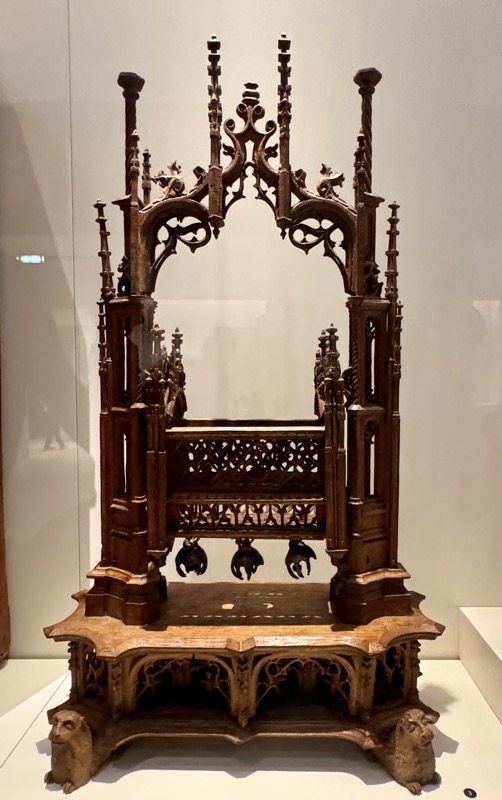
















Four tapestries – Tapestry cycie on seigneurial life
Paris (P), early 15 century. Wool and silk
This ensemble of millefieur tapestries (set against a background of floral motifs) represents the activities of the elite of the late Middle Ages: taking walks, bathing with music, embroidery, reading and spinning. Lacking a sign of ownership and reusing the same figures, it was likely woven prior to purchase, to be presented to potential buyers sure to be impressed by its bucolic décor.
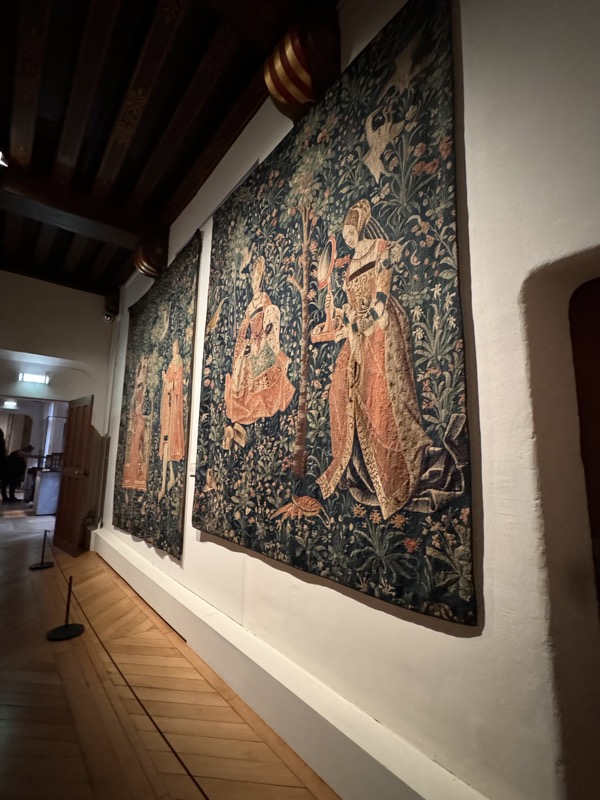


Board game box, France, about 1500.
Stained bone and walnut wood, ebony, ivory.
Made with noble materials, this game box executed in France is one of the oldest known. The pawns and pieces, made of ivory, bone or wood, came from Europe and were designed at various times.
It contained at least six different games, testifying to the taste for entertainment in the Middle Ages.
Some of these games are still familiar to us, such as chess and tric-trac (a kind of backgammon), while others have disappeared: nine-men’s morris, “fox and geese”, tourniquet, and glick (the ancestor of poker).

Lidded hexagonal salt cellar. Italy, 1370. Pewter.


Drinking horn in the shape of a griffin’s claw – Germanic countries, about 1500.
Horn, engraved and gilded copper.
This bull’s horn, mounted in a precious metal setting, rests on eagle talons that evoke a griffin, a legendary animal that is half-eagle, half-lion. Saint Corneille, a pope, was said to have received a claw from a griffin he cured. Transformed into a drinking cup, the claw was believed to detect poison in drinks. A sign of wealth, this object may have decorated a table or dresser where precious dinnerware was displayed.




Pavise – Portcullis. Germanic countries, 1st quarter of the 16th century. Wood.

Pavise – David and Goliath. Bohemia, about 1480. Wood, fabric, leather, paint.
This pavise, whose lower part is missing, was used during the Hussite wars, as a tool in the context of an entirely original military organisation. Pavisiers (who earned more than other foot soldiers) held the shields in place, while pike men stood behind them. They could sustain heavy cavalry charges and successfully repel them.



Targe – Maltese Cross and roses. Germanic countries, last quarter of the 15thC, wood, paint.
This small targe was used in “courtesy” jousting (a joust à plaisance, as opposed to joust à outrance, or grudge matches, where opponents could fight to the death), or even during simple demonstrations.
During jousting, it would be held to the left armpit, protecting it while marking the target on which the opponent should break his lance.

Two cups and a dish. Manises, early 16th century Ceramic with metallic lustre.
Though purchased together, the cup on the right and the dish above it do not necessarily go together. They nonetheless share similarities with the other cup, like their golden lustred decor and the choice of a pseudo-heraldic motif for their ombilics (central circles in relief). The base of the cups features a motif resembling musical notes, called solfa. The care taken with the plant motifs and the harmony of colours with metallic highlights are in line with vessels created in Valencia from the late 15th century, when blue disappeared in favour of golden monochrome, accentuating a likeness to metalware. The gadroons (moulding in relief) reinforce the similarity to copper dishware.

Marten head – northern Italy, late 15th or 16th century Gilded copper, glass, bone.
This object, composed of a copper mount enclosing the head of a marten (animal associated with fertility) was likely placed at the end of a fur, as shown by the fastening holes in the metal. “Lice furs” in the form of martens, sables, foxes or beech martens, meant to serve as lice traps, were worn over the shoulder or attached to a belt. Certain furs were adorned with rock crystal and precious stones on their extremities.

Reliquary-monstrance. Lombardy region (Italy),
last quarter of the 15th century Cast, embossed, engraved and gilded copper, painted enamel, glass.
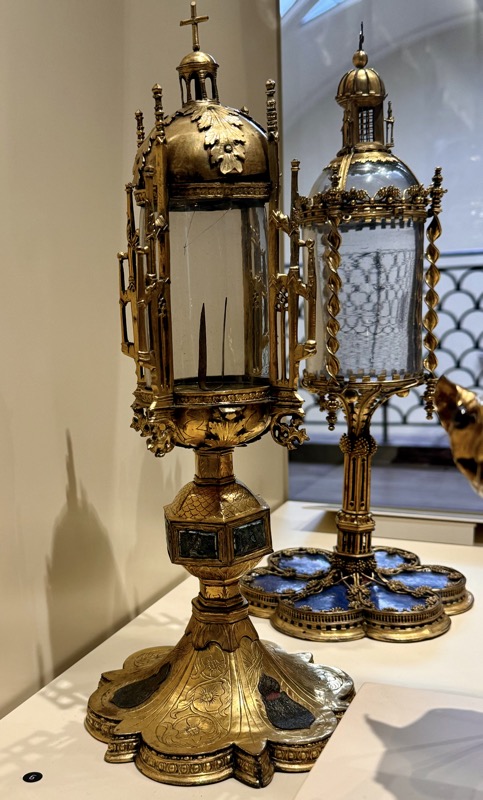
Papal rings in the name of Popes Paul II (1464-1471) and Sixtus IV (1471-1484)
Central Italy, 2d half of the 15th century Gilded copper alloy, rock crystal; red foil (CI. 9192)
Inscriptions: PIA/PA PAULO; P[A]PA SIXTUS.
These imposing rings, adorned with symbols of the evangelists, each bear the name of a pope. One of them also displays Pope Sixtus IV’s coat of arms (CI.9192). They were worn on top of gloves (by papal legates?). Some sixty of these rings dating to the 15′ century have survived to this day.


